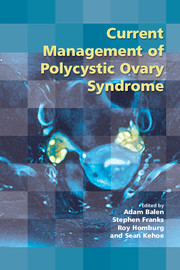Book contents
- Frontmatter
- Contents
- Participants
- Declarations of personal interest
- Preface
- 1 Overview and definitions of polycystic ovary syndrome and the polycystic ovary
- 2 Genetics and pathogenesis of polycystic ovary syndrome
- 3 Ethnic variations in the expression of polycystic ovary syndrome
- 4 Quality of life for women with polycystic ovary syndrome
- 5 Insulin resistance, the metabolic syndrome and polycystic ovary syndrome
- 6 Management of polycystic ovary syndrome through puberty and adolescence
- 7 Long-term health risks of polycystic ovary syndrome
- 8 Approaches to lifestyle management in polycystic ovary syndrome
- 9 Management of obesity in polycystic ovary syndrome, including anti-obesity drugs and bariatric surgery
- 10 Definition of hyperandrogenism
- 11 Treatment of hyperandrogenism in polycystic ovary syndrome
- 12 Choices in the treatment of anovulatory polycystic ovary syndrome
- 13 Predictors of ovarian response to ovarian stimulation: progress towards individualised treatment in ovulation induction
- 14 Surgical management of anovulatory infertility in polycystic ovary syndrome
- 15 The role of insulin-sensitising drugs in the treatment of polycystic ovary syndrome
- 16 The role of in vitro maturation of oocytes for anovulatory polycystic ovary syndrome
- 17 Acupuncture and/or herbal therapy as an alternative or complement for relief of polycystic ovary syndrome-related symptoms
- 18 Consensus views arising from the 59th Study Group: Current Management of Polycystic Ovary Syndrome
- Index
16 - The role of in vitro maturation of oocytes for anovulatory polycystic ovary syndrome
Published online by Cambridge University Press: 05 July 2014
- Frontmatter
- Contents
- Participants
- Declarations of personal interest
- Preface
- 1 Overview and definitions of polycystic ovary syndrome and the polycystic ovary
- 2 Genetics and pathogenesis of polycystic ovary syndrome
- 3 Ethnic variations in the expression of polycystic ovary syndrome
- 4 Quality of life for women with polycystic ovary syndrome
- 5 Insulin resistance, the metabolic syndrome and polycystic ovary syndrome
- 6 Management of polycystic ovary syndrome through puberty and adolescence
- 7 Long-term health risks of polycystic ovary syndrome
- 8 Approaches to lifestyle management in polycystic ovary syndrome
- 9 Management of obesity in polycystic ovary syndrome, including anti-obesity drugs and bariatric surgery
- 10 Definition of hyperandrogenism
- 11 Treatment of hyperandrogenism in polycystic ovary syndrome
- 12 Choices in the treatment of anovulatory polycystic ovary syndrome
- 13 Predictors of ovarian response to ovarian stimulation: progress towards individualised treatment in ovulation induction
- 14 Surgical management of anovulatory infertility in polycystic ovary syndrome
- 15 The role of insulin-sensitising drugs in the treatment of polycystic ovary syndrome
- 16 The role of in vitro maturation of oocytes for anovulatory polycystic ovary syndrome
- 17 Acupuncture and/or herbal therapy as an alternative or complement for relief of polycystic ovary syndrome-related symptoms
- 18 Consensus views arising from the 59th Study Group: Current Management of Polycystic Ovary Syndrome
- Index
Summary
In vitro fertilisation (IVF) and embryo transfer is an established and successful form of treatment for infertility. Recent data from the Human Fertilisation and Embryology Authority (HFEA) show consistently improving IVF success rates. The live birth rate per IVF cycle is mainly dependent on female age: during 2007, the average live birth rate per cycle started for women younger than 35 years in the UK was 32.3%, although many clinics are achieving rates of over 40%. During standard IVF treatment, in vivo matured metaphase II (MII) stage oocytes are aspirated from follicles measuring 14-20 mm in diameter. To achieve this, gonadotrophin ovarian stimulation is used, most commonly after achieving pituitary suppression using a gonadotrophin-releasing hormone (GnRH) agonist (long-protocol IVF).
However, these high rates of success are achieved at the expense of two major complications, namely multiple pregnancy and ovarian hyperstimulation syndrome (OHSS). Over 25% of the IVF live births described above were multiple. This results from the fairly routine transfer of multiple embryos to the uterine cavity in an attempt to overcome low implantation rates, particularly in older women. Moreover, in order to have multiple embryos available for transfer, ovarian stimulation is required, which places the woman at risk of developing OHSS. There has been much recent focus on reducing both the rate of multiple pregnancy and also the rate of OHSS. Prolonged embryo culture to day 5 or 6 (blastocyst stage) with replacement of a single embryo maintains pregnancy rates while significantly reducing the multiple pregnancy rate. However, the rate of embryo attrition means that multiple oocytes need to be retrieved and successfully fertilised to allow sufficient good-quality day 3 embryos to continue culture to day 5.
Keywords
- Type
- Chapter
- Information
- Current Management of Polycystic Ovary Syndrome , pp. 185 - 194Publisher: Cambridge University PressPrint publication year: 2010



